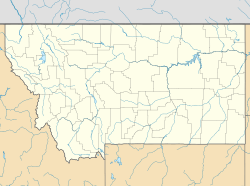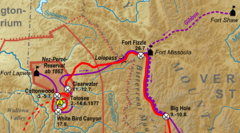Fort Fizzle (Montana) facts for kids
Fort Fizzle was a temporary military barricade built by the U.S. Army in July 1877. Its goal was to stop the Nez Perce people as they fled from north central Idaho. They were trying to cross Lolo Pass into the Bitterroot Valley of western Montana. The fort's name, "Fizzle," describes how well it worked – or didn't!
Quick facts for kids |
|
|
Fort Fizzle Site
|
|
| Nearest city | Lolo, Montana |
|---|---|
| Area | 120.4 acres (48.7 ha) |
| Built by | U.S. Army |
| NRHP reference No. | 77000821 |
| Added to NRHP | July 21, 1977 |
Contents
Why the Nez Perce Were Fleeing
In the Nez Perce War of 1877, the U.S. Army fought the Nez Perce people. The Nez Perce, led by Chief Joseph, had just been in the Battle of the Clearwater in July. Even though they were defeated, they were not ready to give up.
About 200 Nez Perce warriors and 750 people in total, with over 2,000 horses, decided to escape. They planned to cross Lolo Pass into the Bitterroot Valley. From there, they hoped to reach the Great Plains.
Looking for Safety in Montana
The Nez Perce knew this area well. They often traveled through it to hunt buffalo on the plains. Their leader, Looking Glass, convinced the other Nez Perce leaders. He believed they would be safe from the U.S. Army in Montana. He also thought he could lead them to safety among his friends, the Crow Indians.
The Army's Plan to Stop Them
White settlers and U.S. Army soldiers in the Bitterroot Valley heard the Nez Perce were coming. They got the news by telegraph and prepared to defend themselves. Captain Charles Rawn had only 35 soldiers to protect the valley.
On July 23, two young white men, who had been held by the Nez Perce, reported to Rawn. They said the Nez Perce were camped at Lolo Hot Springs. This was on the Montana side of the pass, very close to the white settlements. The young men had been released to deliver a message. The Nez Perce wanted to pass through the settlements peacefully. However, Rawn was ordered to "compel the Indians to surrender their arms." He was told to stop them from entering the Bitterroot Valley by force.
Building Fort Fizzle
On July 25, Captain Rawn, his 35 soldiers, and 50 civilian volunteers built a wooden barricade. They used logs and earth. It was about 2 or 3 miles below the Nez Perce camp. It was also about 5 miles west of Lolo, Montana.
On July 26, Rawn met with Looking Glass. Looking Glass asked to travel through the Bitterroot Valley without fighting. Rawn demanded that the Nez Perce give up their weapons. The meeting ended without an agreement.
Volunteers Leave the Fort
The next day, July 27, 216 armed men were at the fort. This included 15 to 20 Flathead Indian scouts. The Governor of Montana, Benjamin F. Potts, had also arrived. Rawn and Looking Glass met again, and both repeated their demands.
When Rawn returned to the fort, he said he expected a battle. Most of the volunteers then left. They said they didn't want to start a fight with the Indians. The next morning, July 27, fewer than 100 men were left at the fort. Governor Potts had also decided to leave.
How the Nez Perce Bypassed the Fort
According to Chief Joseph, Captain Rawn agreed to let the Nez Perce pass peacefully. Rawn, however, never admitted to making such a deal.
The fort was in a narrow canyon, about 200 yards wide. Steep ridges on both sides made it seem impossible to pass. But on July 28, the Nez Perce, including men, women, children, and their animals, climbed the ridges to the north. They went around the barricade, leaving the soldiers behind them.
Rawn and his soldiers fired a few shots at the Nez Perce on the ridge. Then they left the fort and followed them into the Bitterroot Valley from a safe distance. An advance group of soldiers met the Nez Perce rear guard. Looking Glass greeted them in a friendly way. Fifty civilian volunteers accidentally walked into the Nez Perce camp. They were captured but then released after Looking Glass promised no harm. The soldiers went back to Missoula, and the volunteers went home. The Nez Perce continued south through the Bitterroot Valley. They bought fresh horses, food, and supplies from local ranchers and farmers.
This is how the makeshift fort earned its name: "Fort Fizzle."
What Happened After Fort Fizzle
The "Fort Fizzle" event caused many arguments. People accused each other of being cowardly or unskilled. One volunteer explained that they didn't want to "uselessly incite the Indians to devastate our valley." Many Montanans, including the governor and journalists, began to praise the Nez Perce's "bravery." They also thought the citizens were wise to avoid a fight.
However, the Nez Perce's time of peace did not last long. They felt safe after passing through the Bitterroot Valley. But on August 9, Colonel John Gibbon and 200 men attacked them. This led to the bloody Battle of the Big Hole.
Visiting Fort Fizzle Today
A part of the fort has been rebuilt at the Fort Fizzle Historic Site. It is next to U.S. Route 12. The site is along the historic Lolo trail. This trail was used by the Nez Perce, Salish, and Kootenai tribes. The Lewis and Clark also used this trail. Lewis and Clark traveled up Lolo Creek in September 1805. They visited the area again in June 1806 on their way back east.





